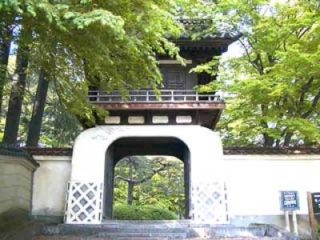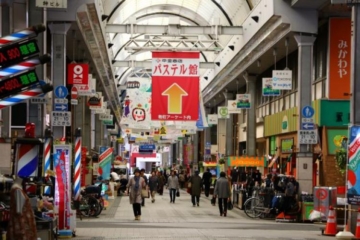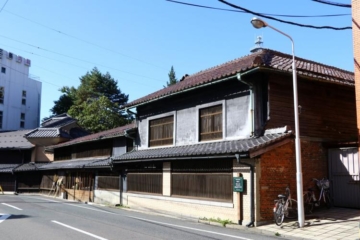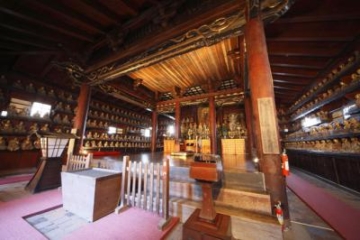MODEL COURSE
Morioka Station
10 minutes
Daijiji Temple

Daijiji Temple, also known as Hara Takashi's family temple, was built in 1673 with a rare Chinese-style temple gate. The hall was destroyed in a fire in 1899, but the Sanmon gate and the warehouse were rebuilt thanks to Takashi Hara's generosity.
Detailed Destination Information2 minutes
Seiryu water
5 minutes
Morioka Machiya Story Museum
Morioka Machiya Monogatari Museum opened in July 2014 with the concept of ``encountering nostalgic bustle.''
As a lively and nostalgic place for relaxation that is easy for everyone to use, it also serves as a local information center and a place to disseminate information on local culture.
As a new regional core facility, we are working together with the citizens to operate it.
In addition, we will take advantage of the five functions of this facility: ``interact,'' ``see,'' ``experience,'' ``eat,'' and ``buy.''
We aim to preserve and disseminate not only the charm of our facilities, but also the many fascinating lifestyle cultures of the Katayacho area as resources.
5 minutes
Sakemachi Shopping Street

Located on the east side of the city center, Morioka's only shopping street with a canopy arcade. There are a wide variety of shops lined up, and you can enjoy shopping without worrying about rain, wind, or snow.
Detailed Destination Information3 minutes
Morioka Takuboku/Kenji Seishunkan

``Morioka Takuboku/Kenji Seishunkan'' preserves and utilizes the former 90th Bank, which was completed in 1909, to introduce the town of Morioka where Takuboku Ishikawa and Kenji Miyazawa grew up and their youth. Masu. July 6, 2004 Designated as a national important cultural property
Detailed Destination Information2 minutes
Iwate Bank Red Brick Building

It opened as Iwate Bank Red Brick Building on Sunday, July 17, 2016. Built to the design of Kingo Tatsuno and Manji Kasai Architects, the former Morioka Bank is built of red brick with a green dome, and its exterior has a strict Renaissance-style outline. Located in the center of the city, it combines with the Nakatsu River and Nakano Bridge to form Morioka's representative landscape. A nationally designated important cultural property built in 1909.
Detailed Destination Information2 minutes
Goza nine

Gozaku, which still retains the image of a wealthy merchant, was a merchant house that sold lanterns for lanterns and straw crafts from the late Edo period to the Meiji period. The buildings, which have castle walls, tiles, and low eaves with lattice doors, have been built one after another, and you can get a glimpse of each era.
Detailed Destination Information1 minute
Konyamachi Banya

The remains of the fire station, which was built in 1913 (Taisho 2) and is a Morioka city landscape important building. After undergoing earthquake-proofing and renovation work, it reopened as a new exchange experience facility in March 2022 (Reiwa 4). There is a cafe and miscellaneous goods sales on the first floor, and a weaving workshop on the second floor, where you can also experience it by making a reservation. You can relax in a restaurant that exudes Taisho romance.
Detailed Destination Information5 minutes
upper bridge fake jewel

The bridge above was built by Toshinao, the lord of the Nanbu domain, over the Nakatsugawa River at the same time as he built Morioka Castle. Of the bronze imitation jewels decorating the railing, eight have inscriptions dated to 1609 (Keicho 14), and 10 have inscriptions dated to 1611 (1611). It is extremely rare that so many remain, and in 1945 it was designated as a nationally important art object.
Detailed Destination Information4 minutes
Shotaro Hirano Store
7 minutes
Mitsuishi Shrine

Behind Token-ji Temple, there is Mitsuishi Shrine, which is made up of three huge granite stones, and there is a legend of a demon's handprint on these three stones, which is said to be the origin of the name Iwate. It is also the legendary birthplace of the Sansa dance.
Detailed Destination Information6 minutes
Hoonji Temple/Gohyaku Rahats

An ancient temple of the Soto sect, the principal image is Shaka Nyorai. The Arhat statue housed in Arhat Hall was created by nine Buddhist sculptors in Kyoto over a period of four years starting in 1731. All are made of marquetry and lacquered, and some of the statues include Marco Polo and Kublai. A cultural property designated by Morioka City.
Detailed Destination Information10 minutes
Morioka Station

![[Tekuteku Tour of Morioka] Morioka retro trip](https://iwatetabi.jp/wp/wp-content/uploads/2024/03/3250.jpg)
![[Taxi plan] Iwate reconstruction support Minamisanriku course](https://iwatetabi.jp/wp/wp-content/uploads/2024/03/3531-360x240.jpg)
![[Snow and hot springs! Touring the foothills of Mt. Iwate in winter] 7-hour course](https://iwatetabi.jp/wp/wp-content/uploads/2024/03/1773-2-360x240.jpg)
![[Morioka hometown guide] D course](https://iwatetabi.jp/wp/wp-content/uploads/2024/03/2408-360x240.jpg)